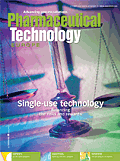Braille packaging & European generics growth
Pharmaceutical Technology Europe
Adding Braille to pharmaceutical packaging should be less of a challenge with the use of Esko-Graphics' Scope solution. EC Directive 2004/27/CE requires Braille labelling and information to be provided with pharmaceutical products for human use, and companies are scrambling to implement this by 31 October.
Braille Packaging Compliance
Adding Braille to pharmaceutical packaging should be less of a challenge with the use of Esko-Graphics' Scope solution. EC Directive 2004/27/CE requires Braille labelling and information to be provided with pharmaceutical products for human use, and companies are scrambling to implement this by 31 October.
The basic Braille unit comprises six dots, two columns across and three rows down. The characters themselves require a fairly large, defined area on the packaging so descriptions are typically brief. However, the real challenge of adding Braille text isn't the mechanics of adding relief dots, it's having a flexible and efficient workflow in place to streamline the internal processes to quickly and effectively comply with this new regulation.

Using Scope, the Braille text can be copied directly in register into the die-shape. Whatever changes the structural designer makes, the graphic designer is always sure to work with the correct version of the die. The graphic designer can also use the rich content of the die-shape to get a 3D preview of the work, eliminating communication errors and reducing design review cycles. In addition, Scope covers a wide range of functions, from job and product specification, through graphic and structural design and expert preproduction operations.
European Generics Boom
Off-patent drugs pushing growth
The last few years have seen a rapid growth in the European generics market — the combined result of governments' efforts to encourage the use of generics in a bid to reduce prescription costs and the number of drugs coming off patent. In Europe, Germany is the largest generics market with revenues of $5.4 billion in 2004. The UK and France, other major generics markets, have accumulated revenues of $2.9 billion and $1.6 billion, respectively. Italy has the fastest growing generics market, which, during 2000–2004 expanded at a rate of 137.7%.

Growth of the European generic market 2000-2004
The most lucrative area for the generic market was ethical generic sales, which contributed approximately 83.3% to the total generic market. OTC generics accounted for the remaining 16.7%. The main barriers to OTC generics growth are the dominant position of brand name drugs, and the lack of knowledge of the availability and effectiveness of generic alternatives. By 2009, it is estimated that the European generics market will be worth $19.7 billion with more drugs going off patent and increasing recognition of generics as a cheaper alternative to branded products.

Drug Solutions Podcast: A Closer Look at mRNA in Oncology and Vaccines
April 30th 2024In this episode fo the Drug Solutions Podcast, etherna’s vice-president of Technology and Innovation, Stefaan De Koker, discusses the merits and challenges of using mRNA as the foundation for therapeutics in oncology as well as for vaccines.
Pharmaceutical Tariffs Are Imminent: How Industry is Bracing for Impact
April 16th 2025On April 14, 2025, the Trump Administration launched a national security-driven investigation into pharmaceuticals, a move that will likely result in tariffs being placed on pharmaceutical drugs, ingredients, and other components that are imported from outside of the United States.